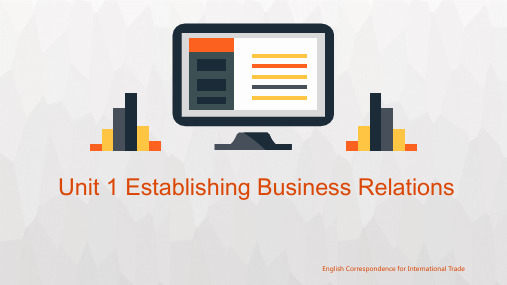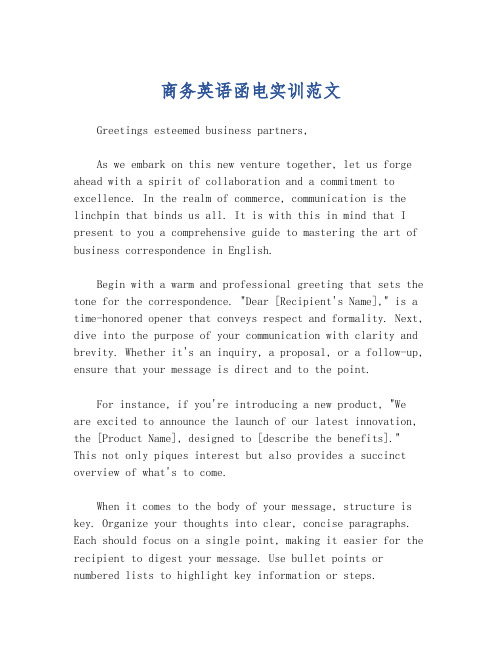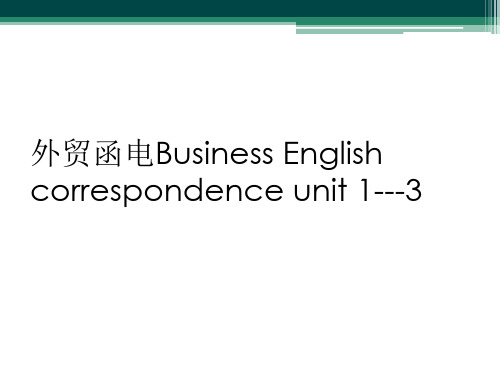商务英语函电实训unit 1 Foundamentals of Business Writing[精]
外贸英语函电教程Unit 1 Establishing Business Relations

01 How to find the customers?
02 How to impress the customers? How to write an email to establish
03 business relations?
04 Language practice
products.
Focus on your unique selling points (USP) to impress Tip 7 your clients.
Activity 1 How to find the customers?
( ) a. I won’t bother to contact those customers who do not
Tip 5 Remember the KISS principle—keep it short and simple.
Activity 1 How to find the customers?
(√) a. I keep good records of all the potential customers to
Keep good records of all the potential clients whom Tip 6 you have contacted. Form a habit of making record of
your work, which increases your work efficiency.
Activity 1 How to find the customers?
Suppose you work for Dongguan Sun Industrial Co., Ltd. which mainly manufactures waterproof materials. You are required to find some new customers in the United States. What do you plan to do in order to find the contact information of potential customers? Tell your partner your ideas and agree on a list of possible ways of finding customers.
外贸函电unit one

Business English Correspondence •Establishing Trade RelationsDear Manager:You were recommended to our company by the Bank of China, New Y ork Branch, which told us that you export Chinese textiles and cotton piece goods.Our company imports general merchandise. We have been in business since 1935, and therefore have wide experience in all the lines we handle.Our bankers are Chase Manhattan Bank and the Hong Kong & Shanghai Banking Corporation of Hong Kong. They can provide you information about our business and finances.Please inform us of your trade terms and forward samples and product brochures. We look forward to a productive trade.Sincerely,Michael S. BarnwellManagerMSB/sh•bankers n.开户银行We now have pleasure in confirming that your bankers, The Westminster Bank Ltd., have accepted our Draft for US $6,000, payable within thirty days of sight. 我方高兴地确认,贵方开户行—西敏寺银行已对我方30天期限的6000美元的汇票予以承兑。
商务英语函电实训范文

商务英语函电实训范文Greetings esteemed business partners,As we embark on this new venture together, let us forge ahead with a spirit of collaboration and a commitment to excellence. In the realm of commerce, communication is the linchpin that binds us all. It is with this in mind that I present to you a comprehensive guide to mastering the art of business correspondence in English.Begin with a warm and professional greeting that sets the tone for the correspondence. "Dear [Recipient's Name]," is a time-honored opener that conveys respect and formality. Next, dive into the purpose of your communication with clarity and brevity. Whether it's an inquiry, a proposal, or a follow-up, ensure that your message is direct and to the point.For instance, if you're introducing a new product, "We are excited to announce the launch of our latest innovation, the [Product Name], designed to [describe the benefits]." This not only piques interest but also provides a succinct overview of what's to come.When it comes to the body of your message, structure is key. Organize your thoughts into clear, concise paragraphs. Each should focus on a single point, making it easier for the recipient to digest your message. Use bullet points or numbered lists to highlight key information or steps.In the realm of negotiation, be assertive yet diplomatic. Phrases like "We believe that a mutually beneficial agreement can be reached if we consider [specific terms]" demonstrate a willingness to compromise while maintaining a firm stance on your company's interests.Closing your correspondence with a call to action is crucial. Whether it's scheduling a meeting, requestingfurther information, or confirming an order, make it clear what the next step should be. "We look forward to your prompt response and are eager to take our partnership to new heights."End with a courteous closing such as "Best regards," or "Sincerely," followed by your name, title, and contact information. This leaves a lasting impression of professionalism and accessibility.Remember, the essence of business English communication lies in its clarity, politeness, and effectiveness. With these principles in mind, your correspondence will not only be a reflection of your company's values but also a catalyst for successful business interactions.。
外贸函电Business English correspondence unit 1---3

Give up stereotyped words ห้องสมุดไป่ตู้nd informal words
(1) Awaiting your reply, we remain. (2) Beg to advise… (3) Your esteemed favour… (4) Attached hereto… (5) Let me call your attention. (6) Assuring you of our appreciation. (7) Letter under the date of… (8) Your good-selves…
5 The company's manpower needs will continue to grow next year
6 Nearly all our salesmen are against the proposed changes to the bonus system
7 We congratulate both Mr Smith and Miss Duffy on their success in the recent sales competition.
Pay attention to the rhetoric
You told us that you did not receive the samples. We are sorry to learn that you did not receive the samples. We have received your order. Thank you for your order.
We believe that our letter of January 20th , 2004 may not have stressed sufficiently how favorable our price quoted to you is. It’s hoped we shall have your order as soon as possible.(within the next few days)
商务英语函电实训unit 1 Foundamentals of Business Writing

The purpose for business writings is to inform readers of information you want to get across or possibly persuade the readers to do something.
Unit 1 Foundamentals of Business Writing
Unit 1 Foundamentals of Business Writing
• 1.Guide to Basic Business Letters
The basics of good business letter writing are easy to learn. The following guide provides the phrases that are usually found in any standard business letter. These phrases are used as a kind of frame and introduction to the content of business letters. At the end of this guide, you will find links to sites that give tips on the difficult part of writing successful business letters – arguing your business objective. By using these standard phrases, you can give a professional tone to your English business letters.
(完整版)《商务英语函电教程》Unit1商务信函写作基础

➢ These are marked “Our ref:” and “Your ref:” to avoid confusion:
Your ref: AMD/IP
Our ref: WRL/QN
position:
They are often placed two lines below the letterhead.
15 PARKGTE ROAD, LONDON SW12 4NQ. U.K.
Reference
Include:
a file number, departmental code or the initials of the signer followed by that of the typist of the letter.
Letterhead Reference Dateline Inside Name and Address Salutation Subject Line Body Complimentary Close Signature
Letterhead
Letterhead includes the sender’s name, postal address, the company’s logo, telephone number, telex number, cable address and
Shanghai Huali Imp. & Exp. Co., Ltd
Room 606 Plaza Building,
Fax: 86-21-64253378
1302 Meilong Road, 200237
Tel: 86-21-64255578
Shanghai, People’s Republic of China E-mail:huali188@
商务英语函电专业课教案Unit

商务英语函电专业课教案Unit 1-5一、Unit 1: Introduction to Business English Correspondence Objective:To familiarize students with the importance of business English correspondence and its role in international business munication. Content:1. Definition and types of business English correspondence.2. Importance of business English correspondence in international trade.3. Basic ponents of a business letter.Activities:1. Discuss the importance of business English correspondence in groups.2. Analyze sample business letters to identify the basic ponents.3. Practice writing a simple business letter.Assessment:1. Group discussion participation.2. Analysis of sample letters.3. Written assignment: Write a business letter.二、Unit 2: Elements of Effective Business WritingObjective:To teach students the essential elements of effective business writing. Content:1. Clarity and conciseness.2. Correct grammar and punctuation.3. Professional tone and language.4. Organized structure and format.Activities:1. Analyze sample letters with ineffective writing elements.2. Practice writing exercises focusing on clarity, conciseness, grammar, and punctuation.3. Discuss the importance of professional tone and language.4. Create a business letter template.Assessment:1. Analysis of sample letters.2. Writing exercises.3. Business letter template creation.三、Unit 3: Writing Professional Business LettersObjective:To guide students in writing professional business letters.Content:1. Formatting business letters.2. Writing clear and concise sentences.3. Using proper salutations and closing.4. Proofreading and editing.Activities:1. Study different business letter formats.2. Practice writing clear and concise sentences.3. Role-play different scenarios requiring business letters.4. Edit and proofread sample letters.Assessment:1. Formatting and structure of written assignments.2. Clarity and conciseness of written assignments.3. Correct salutations and closings.四、Unit 4: Business E CommunicationObjective:To familiarize students with the appropriate use of business e munication.Content:1. Differences between business letters and es.2. Rules for effective business e munication.3. Formatting and structuring business es.4. Sample business e templates.Activities:1. Compare business letters and es.2. Discuss rules for effective business e munication.3. Practice writing business es using sample templates.4. Peer review and feedback on e writing.Assessment:1. Comparison of business letters and es.2. Writing exercises using sample templates.3. Peer review and feedback.五、Unit 5: Writing Effective Business Proposals Objective:To teach students how to write effective business proposals. Content:1. Understanding the purpose of a business proposal.2. Elements of a successful business proposal.3. Structuring and formatting business proposals.4. Writing persuasive and pelling proposals.Activities:1. Analyze sample business proposals.2. Practice writing a business proposal.3. Role-play presenting business proposals.4. Provide feedback on peer proposals.Assessment:1. Analysis of sample proposals.2. Writing exercises: writing a business proposal.3. Presentation skills and feedback.六、Unit 6: Formatting and Structuring Business ReportsObjective:To guide students on how to format and structure business reports effectively.Content:1. Basic ponents of a business report.2. Formatting guidelines for business reports.3. Structuring the report for clarity and effectiveness.4. Using appropriate language and tone in reports.Activities:1. Analyze sample business reports to understand their ponents.2. Practice formatting and structuring a business report.3. Discuss the use of language and tone in reports.4. Peer review and feedback on report writing.Assessment:1. Analysis of sample reports.2. Formatting and structure of written assignments.3. Use of language and tone in reports.七、Unit 7: Writing Effective Memos and NotesObjective:To familiarize students with the skills required to write effective memos and notes.Content:1. Differences between memos and notes.2. Purposes and uses of memos and notes in business munication.3. Formatting and structuring memos and notes.4. Examples of effective memos and notes.Activities:1. Discuss the differences between memos and notes.2. Practice writing a memo and a note.3. Analyze sample memos and notes to understand their structure.4. Peer review and feedback on memo and note writing. Assessment:1. Analysis of sample memos and notes.2. Writing exercises: writing a memo and a note.3. Peer review and feedback.八、Unit 8: Business Negotiation CorrespondenceObjective:To teach students how to write effective business negotiation correspondence.Content:1. Purpose and importance of business negotiation correspondence.2. Strategies for writing effective negotiation letters.3. Sample negotiation scenarios and corresponding letters.4. Language and tone in negotiation correspondence.Activities:1. Discuss the purpose and importance of business negotiation correspondence.2. Practice writing negotiation letters based on sample scenarios.3. Role-play negotiating based on the written letters.4. Provide feedback on peer negotiation correspondence. Assessment:1. Analysis of sample negotiation letters.2. Writing exercises: writing a negotiation letter.3. Negotiation skills and feedback.九、Unit 9: Writing Business PlansObjective:To guide students on how to write effective business plans. Content:1. Understanding the purpose of a business plan.2. Elements of an effective business plan.3. Structuring and formatting the business plan.4. Writing clear and concise objectives and strategies.Activities:1. Analyze sample business plans to understand their elements.2. Practice writing a business plan.3. Discuss the use of language and tone in business plans.4. Peer review and feedback on business plan writing. Assessment:1. Analysis of sample business plans.2. Formatting and structure of written assignments.3. Use of language and tone in business plans.十、Unit 10: Emerging Trends in Business Communication Objective:To familiarize students with emerging trends in business munication. Content:1. Overview of emerging trends in business munication.2. Social media and its role in business munication.3. E etiquette and best practices.4. The impact of technology on business munication.Activities:1. Discuss emerging trends in business munication.2. Explore the role of social media in business munication.3. Role-play scenarios involving e etiquette and best practices.4. Analyze the impact of technology on business munication. Assessment:1. Class discussions and participation.2. Analysis of social media's role in business munication.3. Application of e etiquette and best practices.4. Understanding of the impact of technology on business munication. 十一、Unit 11: Case Studies in Business CommunicationObjective:To provide students with real-life examples of business munication scenarios and analyze their effectiveness.Content:1. Case studies of successful and unsuccessful business munication.2. Analysis of the strategies and techniques used in the case studies.3. Identifying lessons learned from the case studies.4. Application of knowledge from case studies to practical scenarios. Activities:1. Present and discuss assigned case studies.2. Analyze the effectiveness of the munication strategies used.3. Identify the key factors that contributed to the success or flure of the munication.4. Role-play applying the lessons learned from the case studies to practical scenarios.Assessment:1. Analysis and discussion of case studies.2. Application of lessons learned to practical scenarios.3. Peer review and feedback on presentations and role-plays.十二、Unit 12: Professional E and Letter Writing PracticeObjective:To enhance students' proficiency in writing professional es and letters through practice and feedback.Content:1. Review of e and letter writing guidelines.2. Practice writing various types of professional es and letters.3. Peer review and feedback on writing assignments.4. Editing and polishing drafts to create final versions.Activities:1. Review best practices for writing professional es and letters.2. Participate in writing exercises, including responding to mock scenarios.3. Exchange written assignments with peers for review and feedback.4. Revise and refine drafts based on feedback to create polished final products.Assessment:1. Analysis and discussion of best practices for professional writing.2. Quality of written assignments, including clarity, conciseness, and professionalism.3. Improvement shown in revisions based on peer feedback.十三、Unit 13: Business Presentation SkillsObjective:To equip students with the skills needed to deliver effective business presentations.Content:1. Key ponents of a successful business presentation.2. Preparation and organization techniques for presentations.3. Effective use of visual ds and slides.4. Delivery and munication skills during the presentation.Activities:1. Analyze样本商务演讲以了解其关键组成部分。
外贸英语函电Unit One

5.Correctness (正确)
A business letter must be correct. It should refer to correct data, accurate statements and clear opinions. This also means using correct grammar, spelling of words and punctuation. These are the basic elements of all letters. Business letters often are used as commercial or legal documents, so they are indebted with legal rights and obligations. Accurate facts, figures and vocabulary must be chosen wisely.
2.Completeness (完整)
A business letter requires “completeness”. It involves a careful check of the Five W’s: What, Who, Why, Where, When and How. See to it that all these questions are answered and all the matters are referred completely. A complete business letter provides adequate details for your reader to completely understand your intentions.
- 1、下载文档前请自行甄别文档内容的完整性,平台不提供额外的编辑、内容补充、找答案等附加服务。
- 2、"仅部分预览"的文档,不可在线预览部分如存在完整性等问题,可反馈申请退款(可完整预览的文档不适用该条件!)。
- 3、如文档侵犯您的权益,请联系客服反馈,我们会尽快为您处理(人工客服工作时间:9:00-18:30)。
Sample Letter
Unit 1 Foundamentals of Business Writing
• Here is a sample letter using some of these forms:
Dear Mr Flintstone: With reference to our telephone conversation today, I am writing to confirm your order for: 120 x Cheddar Deluxe Ref. No. 856 The order will be shipped within three days via UPS and should arrive at your store in about 10 days. Please contact us again if we can help in any way. Yours sincerely,
Unit 1 Foundamentals of Business Writing
• 2.How to Write a Business Letter
A business letter is a formal means of communication between two people, a person and a corporation, or two corporations. Business letters differ from personal letters because they follow very strictly set rules for composition. Many people are intimidated by the prospect of writing to strict guidelines, however business letters are nothing to be afraid of. They are too useful a tool to be stigmatized by the public.
• The Reason for Writing
I am writing to inquire about apologize for confirm
Unit 1 Foundamentals of Business Writing
• Requesting
Could you possibly? I would be grateful if you could
Unit 1 Foundamentals of Business Writing
• The Start
Dear Personnel Director, Dear Sir or Madam: (use if you don't know who you are writing to) Dear Dr, Mr, Mrs, Miss or Ms Smith: (use if you know who you are writing to, and have a formal relationship with - VERY IMPORTANT use Ms for women unless asked to use Mrs or Miss) Dear Frank: (use if the person is a close business contact or friend)
• PURPOSE OF A BUSINESS LETTER
The purpose for business writings is to inform readers of information you want to get across or possibly persuade the readers to do something.
Unit 1 Foundamentals of Business Writing
• KEEPING YOUR LETTER TO THE POINT The first thing you need to make sure of when writing a business plan is to make sure that you are not wasting the reader’s time. There are two questions to make sure that you are not wasting their time and they are, "why am I writing" and "what do I want to achieve." If you are able to answer theses two questions then, then you writing will be a third of what it would have been if you as a writer just sat down and started to write. It is a good thing that your letter is short because that way you are getting straight to the point of what you want you readers to know.
Unit 1 Foundamentals of Business Writing
• DEFINITION OF A BUSINESS LETTER
A business letter serves the main purpose of communication between two companies, or it is a method to talk to different people within a business.
Unit 1 Foundamentals of Business Writing
• Before you begin writing, answer the following questions: 1. What is my purpose in writing this letter/memo/report? 2. What does my reader want or need to know to understand my message? 3. Have I answered important questions and provided the necessary information for the reader? 4. Did I accomplish my purpose? 5. Have I included boring, confusing, or distracting information? 6. What do I want the reader to do when he or she is done reading this? 7. Is that clear to the reader? 8. Have I included all the information necessary for the reader to take this action?
Unit 1 FoundamentThe Reference
With reference to your advertisement in the Times, your letter of 23 rd March, your phone call today, thank you for your letter of March 5 th .
Conversational Convincing Complete
Unit 1 Foundamentals of Business Writing
If you as a writer are able to effectively do all or part of these seven guidelines, then your paper will be on its way to being a good business letter.
The End
• Agreeing to Requests
I would be delighted to
• Giving Bad News
Unfortunately I am afraid that
Unit 1 Foundamentals of Business Writing
• The Finish
Yours faithfully, (If you don't know the name of the person you're writing to) Yours sincerely, (If you know the name of the person you're writing to) Best wishes, Best regards, (If the person is a close business contact or friend)
Unit 1 Foundamentals of Business Writing
Unit 1 Foundamentals of Business Writing
• 1.Guide to Basic Business Letters
The basics of good business letter writing are easy to learn. The following guide provides the phrases that are usually found in any standard business letter. These phrases are used as a kind of frame and introduction to the content of business letters. At the end of this guide, you will find links to sites that give tips on the difficult part of writing successful business letters – arguing your business objective. By using these standard phrases, you can give a professional tone to your English business letters.
